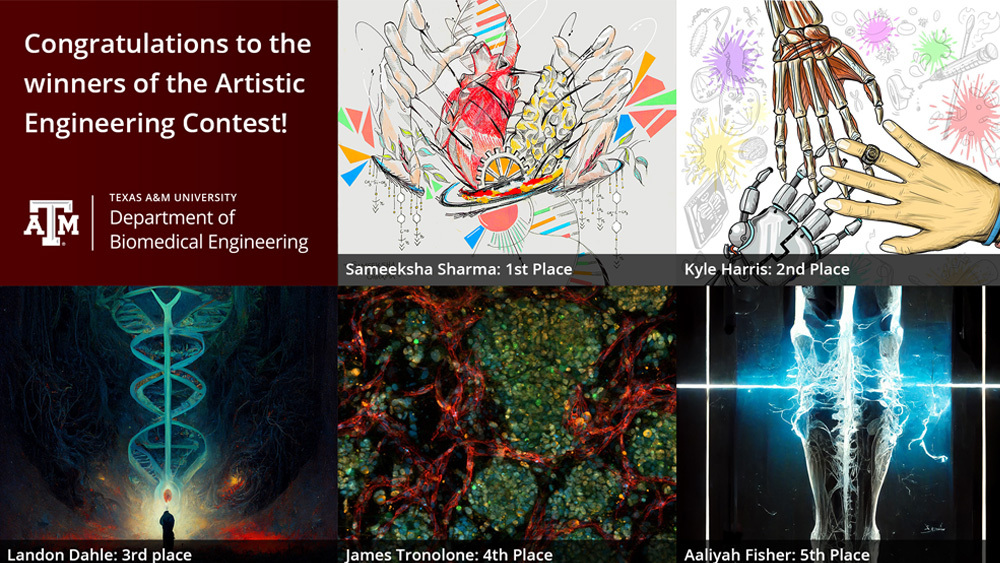
The Department of Biomedical Engineering at Texas A&M University hosted the second annual Artistic Engineering Contest at the start of fall 2022. This initiative began to provide students, faculty and staff opportunities to showcase how they see beauty in engineering and medicine.
Eighteen submissions were reviewed and ranked by members of the department, with the top-five winners now featured prominently near the departmental administrative offices.
Sameeksha Sharma, a junior biomedical engineering student, won first place. She shared that she can’t remember a time when she didn’t love art. Like art, she feels engineering starts with scribbles that are honed until the product can stand the test of time.
“To make my artistic engineering piece, I looked beyond each component to create something that takes the audience on a journey,” Sharma said. “A journey that they can’t unpack in one glance, which makes them step back and find the story that is beyond the sum of its parts.”
Descriptions for the top five art pieces are listed below.
First place: “A Sublime Synthesis” by Sameeksha Sharma ‘24
This work delves into the nuances within the discipline of biomedical engineering and reveals that biological systems have emergent properties. This is illustrated using a vibrant display of a heart, a brain and our shared genetic code. When synthesized in a system, these components create us. Something beyond the sum of their parts. Thus, meaningful biomedical solutions also originate from the synthesis of various approaches. The depiction of polymers and mechanical elements unveils the natural and synthetic inspirations behind biomedical solutions. Overall, this work celebrates the meticulous effort of thousands of biomedical engineers who create transformative results.
Second place: “Synergy” by Kyle Harris ‘25
This digital drawing depicts three hands coming together toward the center of the image: a musculoskeletal one representing biology, a robotic one representing engineering and one representing the biomedical engineering students themselves. Floating around the hands are various medical devices, pieces of equipment and biological elements that emphasize the intertwining of organic and inorganic studies and principles.
Third place: “The Forefront of Knowledge” by Landon Dahle ‘25
This work captures the spirit of exploration and discovery that permeates the study of knowledge. The piece aims to represent the relentless pursuit of knowledge and advancement in science and academia. A towering double helix serves as a metaphor for the huge storehouse of untapped knowledge that academics aim to reach through their work. A figure at the base of the helix appears to discover this knowledge through experimentation. Furthermore, the use of bold colors and a dynamic composition conveys a sense of excitement and ambition.
Fourth place: “Vascularized Ovarian Tumor Microenvironment On-a-Chip” by James Tronolone ‘23
The tumor microenvironment is a complex system consisting of tumor cells, normal and cancer-associated stromal cells and a vasculature that assists the tumor’s therapeutic resistance and immune evasion. Here, a medical device called an organ-on-a-chip is used to model these pathophysiological traits. Tumors (green) are encapsulated in a hydrogel with fibroblasts and endothelial cells (red), cultivated for a few days, and result in a microenvironment where capillary networks fenestrate the spheroids. This device, called a vascularized tumor microenvironment on-a-chip, can be used for targeted drug testing aimed at overcoming the immune evasion and therapeutic resistance of highly-vascularized tumors.
Fifth place: “The Medicine of Technology” by Aaliyah Fisher ‘25
This image was generated by artificial intelligence with the prompt of "healing a bone fracture with electrostimulation." Electrostimulation is a method for speeding up the healing process of a minor bone fracture or break. It uses current to stimulate bone growth so that a bone fracture will heal at a faster pace. The direct symbolism of this therapeutic tool is a tribute to how the crossover of technological advancements in the medical field speeds up the rate of societal evolution.